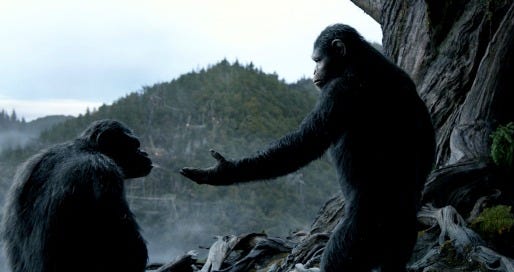Dawn of the Planet of the Apes

Andy Serkis, the actor who has become famous for his motion-capture performances as Gollum in the "Lord of the Rings" trilogy and as Caesar the chimpanzee in "Rise of the Planet of the Apes," receives top billing for reprising his role in the sequel to the latter.
This is notable for a couple of reasons: I believe it's the first time a performer represented digitally through CGI has been credited as the lead actor in a movie also starring live-action performances. This had already been the case with all-CG movies like "Avatar," which essentially were animated films. But here the motion-capture acting stands right beside the live actors. Indeed, it stands taller.
This is appropriate, since the heart and soul of the story in "Dawn of the Planet of the Apes" is about the simians, with the humans acting as the sidekicks. "Rise" featured some chimps and apes blended with puppetry and special effects, but here the apes are all CG.
How good is the digital representation of apes? They seemed as real to me as the humans sharing the frame. Their eyes crinkle with emotion, their brows lower with anger, their throats burble with both simian noises and human-made speech.
If there's a knock to be made against this movie, it's that the live actors don't make as much of an impact as Serkis & Co. Other than Gary Oldman, who has an all-too-brief role as an anxious ex-soldier, most of them are somewhat flat.
That's OK; "Dawn" is still the best summer movie of 2014, with a combination of terrific action scenes and a genuinely moving story about the conflict between apes and people in the aftermath of an apocalypse, and how inhumanity is a trait both tragically share.
Set 10 years down the road from the last movie, "Dawn" sees most of the human population decimated by a biological warfare agent known as the simian flu, and the wars that followed. As the story opens, Caesar has become the grizzled leader of an entire colony of intelligent apes. They hunt other animals for food, and have built a huge wooden village in the forests around San Francisco.
Though they can speak halting English, Caesar and his tribe prefer to communicate through the sign language they were initially taught by humans. They also carry over other of mankind's affectations, such as adorning their faces with war-paint while hunting and riding horses.
It's been two years since they last saw humans, so they doubt any still live. But then they stumble across a party of them led by Marcus (Jason Clarke), who are on a mission to get the old electric dam power generator working again. Human survivors have gathered in a large tower in San Fran, but their fuel is nearly run out.
Misunderstanding and fear initially rule the interactions between man and ape, and blood is shed. But Caesar, worried that a war will mean the death of many of his kind, bends to their requests for help.
This does not sit well with members of his tribe, including his teenage (in temperament, if not years) son, Blue Eyes, and Koba (Toby Kebbell), his right-hand ape. As we know from the last movie, Koba was left scarred and blind in one eye from human medical experiments, and he's not about to forgive and forget.
Some of the most powerful sections in the movie depict the growing conflict between Koba and Caesar. In one scene, Koba sneers at Caesar letting Marcus and his band perform their "human work," touching his wounds as example of that kind's deeds. But they always make up, which consists of the subservient ape bowing before his leader and offering his open hand for a grasp of friendship, indicating he's been forgiven.
But others are not so accommodating, and soon the fight escalates despite the efforts of Caesar and Marcus.
The action scenes are kinetic and hefty; we can almost feel the weight of the great gorillas and chimps as they swing from branch to branch — or girder to girder when they cross the Golden Gate Bridge into the humans' domain. Caesar hates guns and refuses to use them, though later some of his kind make darker choices — as do humans.
(These machine guns, like seemingly all movie iterations, never have to be reloaded.)
There's one terrific early scene where Caesar brings his entire army to the doorstep of the humans. They just sit there, astride horses or on their feet, staring with disdain at their once-betters. Then Caesar opens his mouth and bellows a warning, and all the humans gasp at what they've just heard. You can see etched on their faces the moment their entire worlds crashed down upon them.
Rounding out the cast on the human end are Keri Russell as Marcus' wife, a CDC scientist; Marcus' artistically bent son (Kodi Smit-McPhee); and Carver (Kirk Acevedo), who is Koba's human counterpart, barely able to conceal his hatred of apes. Also making an impression among the apes is Karin Konoval as Maurice, the gentle giant orangutan who is the intellectual leader of the tribe, teaching the younglings and acting as Caesar's conscience.
New director Matt Reeves ("Cloverfield") ably takes over from Rupert Wyatt, who departed to work on another project. Holdover screenwriters Rick Jaffa and Amanda Silver are joined by Mark Bomback, who reportedly did a script polish.
Smart and soulful, humanistic yet full of verve, "Dawn of the Planet of the Apes" is a great piece of entertainment.
4.5 Yaps



